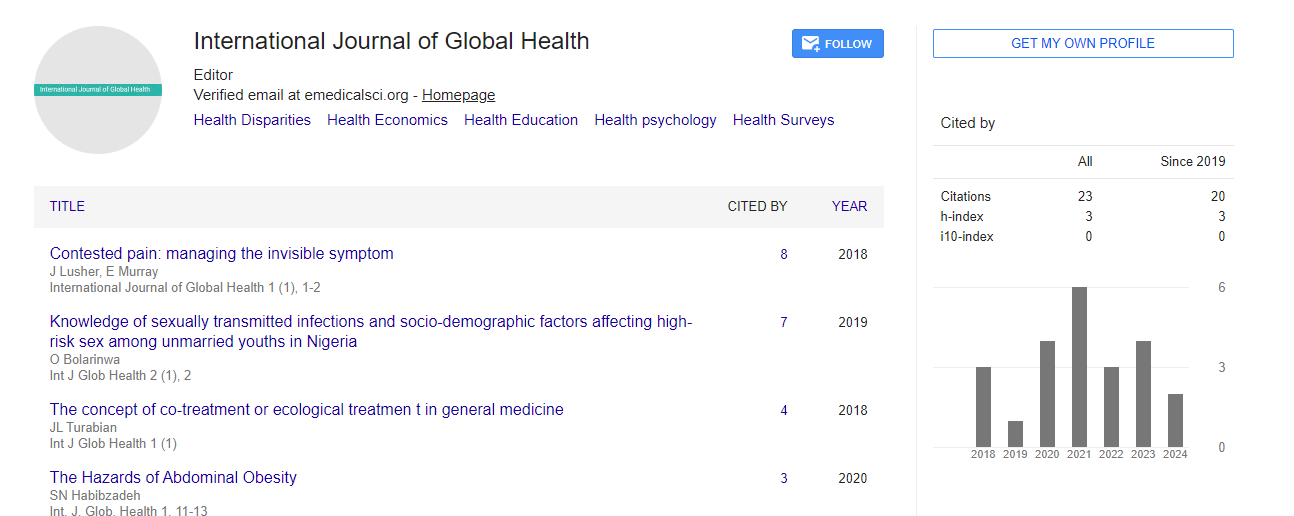Perspective, Int J Glob Health Vol: 7 Issue: 3
Comprehensive Insights into Nephrotic Syndrome: Challenges and Solutions
Moumita Barua*
1Department of Nephrology, University of Toronto, Toronto, Canada
*Corresponding Author: Moumita Barua,
Department of Nephrology, University of
Toronto, Toronto, Canada
E-mail: moumita.barua@uh.ca
Received date: 26 August, 2024, Manuscript No. IJGH-24-148986;
Editor assigned date: 28 August, 2024, PreQC No. IJGH-24-148986 (PQ);
Reviewed date: 11 September, 2024, QC No. IJGH-24-148986;
Revised date: 18 September, 2024, Manuscript No. IJGH-24-148986 (R);
Published date: 25 September, 2024, DOI: 10.4172/Ijgh.1000208.
Citation: Barua M (2024) Comprehensive Insights into Nephrotic Syndrome: Challenges and Solutions. Int J Glob Health 7:3.
Abstract
Description
Nephrotic syndrome is a clinical condition characterized by a collection of symptoms resulting from damage to the glomeruli, the filtering units of the kidneys. This syndrome is marked by significant proteinuria, hypoalbuminemia, edema and hyperlipidemia. While nephrotic syndrome can occur at any age, it is particularly prevalent in children. Understanding its etiology, clinical features and diagnostic approach and management strategies is essential for healthcare providers, patients and caregivers. This study provides a comprehensive overview of nephrotic syndrome. The primary feature of nephrotic syndrome is increased permeability of the glomerular filtration barrier, leading to excessive protein loss in urine. Minimal Change Disease (MCD) most common cause of nephrotic syndrome in children, MCD is characterized by no visible changes on light microscopy. It is often responsive to corticosteroid treatment.
Focal Segmental Glomerulosclerosis (FSGS) condition involves scarring in some segments of the glomeruli. It can occur as a primary disease or secondary to conditions such as obesity, hypertension, or drug toxicity. Membranous Nephropathy results from the thickening of the glomerular capillary wall and can be associated with infections, autoimmune diseases, or certain medications. Nephrotic syndrome can also arise secondary to systemic diseases such as diabetes mellitus (diabetic nephropathy), systemic lupus erythematosus (lupus nephritis) and infections like hepatitis B and HIV. Nephrotic syndrome presents with a range of clinical features, primarily due to the loss of protein and alterations in kidney function. Proteinuria defined as the presence of more than 3.5 grams of protein in urine per day. The urine often appears frothy due to the high protein content. Hypoalbuminemia results in low levels of albumin in the blood (usually <3 g/dL), resulting from excessive protein loss through the urine.
Edema results in accumulation of fluid leads to swelling, particularly in the legs, ankles and abdomen. Severe edema may result in ascites or pleural effusion. Hyperlipidemia results in elevated lipid levels, including cholesterol and triglycerides, occur as the liver compensates for low albumin levels by increasing lipid synthesis. Patients may experience fatigue, loss of appetite and an increased susceptibility to infections due to immunological changes.
Diagnosing of nephrotic syndrome
A thorough medical history and physical examination are essential. Key factors include symptom onset, duration and any associated conditions, such as diabetes or autoimmune disorders. Family history may also be relevant. A dipstick test can detect proteinuria, with confirmation through a 24-hour urine collection to quantify protein excretion. Serum albumin, total protein, cholesterol, triglycerides and creatinine levels are measured to assess kidney function and the extent of protein loss. If secondary causes are suspected, tests for autoimmune diseases, viral infections, or para-proteinemia may be indicated. Ultrasound may be used to assess kidney size and rule out structural abnormalities or obstructions. In certain cases, a renal biopsy may be necessary to determine the underlying cause and guide treatment.
The management of nephrotic syndrome focuses on addressing symptoms, preventing complications and treating the underlying cause when possible. Treatment strategies may include.
Corticosteroids: First-line therapy for primary nephrotic syndrome, particularly in cases of MCD. Prednisone is commonly used, with dosage tailored to the severity of the disease.
Immuno-suppressants: In cases resistant to corticosteroids or with FSGS, medications such as cyclophosphamide, mycophenolate mofetil, or calcineurin inhibitors (e.g., tacrolimus, cyclosporine) may be indicated.
Diuretics: To manage edema, loop diuretics (e.g., furosemide) can help promote fluid excretion.
ACE inhibitors/ARBs: These medications can help reduce proteinuria and control hypertension, also providing renal protection.
Lipid-lowering agents: Statins may be prescribed to manage hyperlipidemia and reduce cardiovascular risk.
Dietary modifications
Dietary changes can support overall health and manage symptoms.
Low-sodium diet: To help control edema and blood pressure.
Moderate protein intake: While protein needs may vary, excessive protein intake should be avoided, particularly in the context of kidney dysfunction.
Heart-healthy diet: Emphasizing fruits, vegetables, whole grains and healthy fats to manage cholesterol levels.
Regular follow-up is essential for monitoring kidney function, managing complications and adjusting treatment plans. This includes routine blood tests and urinalysis to assess disease progression and response to therapy. Patients with nephrotic syndrome are at risk for various complications, including due to immunosuppression and protein loss, patients may require vaccinations and prophylactic antibiotics. The risk of blood clots increases, necessitating monitoring and, in some cases, anticoagulation therapy.
Conclusion
The nephrotic syndrome varies widely depending on the underlying cause and response to treatment. In children with MCD, the prognosis is generally favorable, with most achieving remission. Conversely, FSGS may have a more variable course, with some patients progressing to chronic kidney disease. Long-term follow-up is essential to monitor for complications and assess kidney function. Nephrotic syndrome is a multifaceted condition with significant implications for patients' health and quality of life. Early diagnosis, comprehensive management and ongoing support are essential for optimizing outcomes. By understanding the underlying mechanisms, clinical features and treatment options, healthcare providers can effectively address the needs of individuals with nephrotic syndrome, improving their overall well-being and prognosis.
 Spanish
Spanish  Chinese
Chinese  Russian
Russian  German
German  French
French  Japanese
Japanese  Portuguese
Portuguese  Hindi
Hindi 
